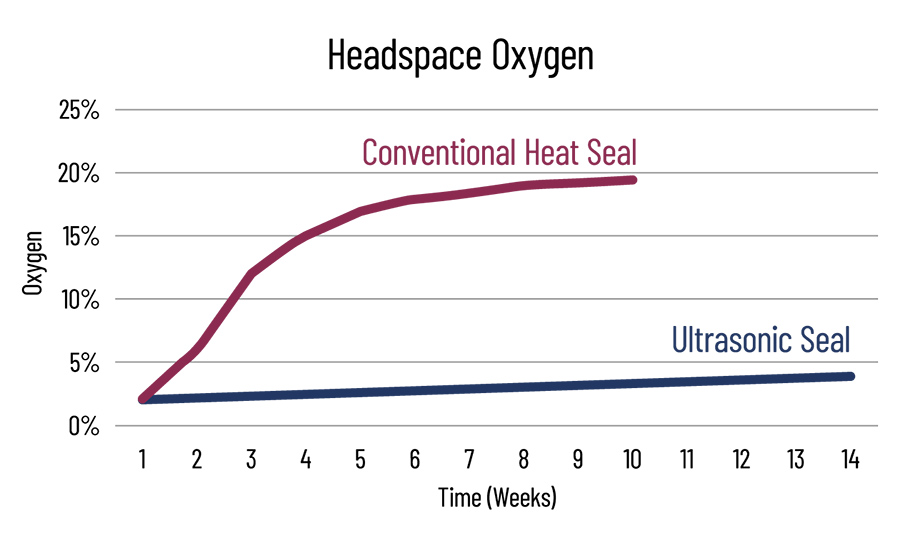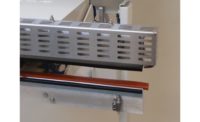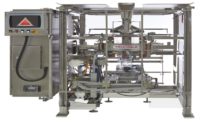So why is ultrasonic sealing technology in the form-fill-seal (F-F-S) pouch space receiving increased attention throughout North America and Europe? Well, consumer packaged goods (CPGs) are evaluating all roads leading to 2025 sustainability mandates, and ultrasonic sealing in the pouch segment delivers many sustainability benefits, including smaller sealing widths, less energy, decreased film material and flexibility — with new sustainable film properties like monomer-based films.
CPGs are now presenting a holistic view of sustainability, including energy efficiency, reducing supply chain waste and, of course, the use of sustainable plastic film material. For example, Nestlé Australia recently touched all these bases with its KitKat chocolate bar. This “circular economy” pilot program included a new type of recycled wrapper for its chocolate bar and the use of an advanced recycling technology called Cat-HTR. Another example is Finland’s Meira and its paper-based coffee packaging pouch that uses Amcor’s AmLite Ultra Recyclable material, but also builds on a messaging environmental stewardship.
Before we begin the roundtable with our industry leaders, what are the basics of ultrasonic sealing F-F-S technology as it relates to film material? The technology relies on acoustic vibrations to generate heat at a molecular level inside of the film itself, and these vibrations, created with an anvil and sonotrode, excite the molecules in the plastic so that they start moving. The result is the plastic becomes soft and starts melting, and the components are bonded by cohesive or form-fit joints.

Courtesy of Sonics & Materials
To get more insights on this technology, Flexible Packaging reached out to these subject matter experts and asked questions about what they were hearing from the market in 2021 and what applications might work. Experts include Bill Aurand, manager of Ultrasonic Applications at LAKO TOOL, Emily Brogan, marketing manager at ROVEMA North America, Inc. and Ken Hundley, internal account manager of packaging at Herrmann Ultrasonics.
Flexible Packaging: How is ultrasonic sealing technology being viewed by the food packaging segment — CPGs and co-packers — in 2021, as it relates to form-fill-seal machinery applications?
Bill Aurand, LAKO TOOL: We have seen renewed interest in ultrasonic sealing, specifically in the snack foods market as increased pressure for sustainability is driving CPGs to reduce film consumption and utilize more recyclable films that perform well with ultrasonic technology. And, rather than completely refurbishing a V-F-F-S bagger to accommodate ultrasonic sealing technology, we’re seeing the use of a standalone ultrasonic sealing module integrated into the machine gain interest. Integrating an independent sealing system into the bagger offers many benefits, including being more reliable and proving to be a better solution for conversion from heat to ultrasonics.
Emily Brogan, Rovema North America: Initially, the cost is in the ballpark of $80,000 higher for a new V-F-F-S solution with ultrasonic sealing versus heat sealing. Depending on the product and application, ultrasonic sealing can have a distinct, positive advantage over heat sealing, with beneficial results on overall equipment effectiveness (OEE) and allowing a positive return-on-investment for the ultrasonic equipment.
Ken Hundley, Herrmann Ultrasonics: We are seeing more and more CPGs show interest in the use of ultrasonics, specifically in the stand-up pouch space, because of the continued challenges of sealing through product contamination. We even have CPGs influencing their co-packers to make the change in order to keep their contracts.
FP: What about ultrasonic sealing technology features? Is the message getting out in the marketplace about the benefits?
Hundley: This concept has been a core aspect of our message for many years. With most companies adopting serious sustainability initiatives, the message is even more relevant. Not only can we reduce scrap, but we also have the potential to reduce the size of the package by reducing the seal surface area as well as headspace, which reduces the overall amount of plastic being used in your package. We’re also seeing that a lot of the new, fully recyclable materials see challenges with conventional sealing methods, but respond quite well to our (Herrmann Ultrasonics) technology.
Aurand: In V-F-F-S applications, sustainability seems to be the main thing driving customer interest. Ultrasonic sealing has shown to reduce film consumption by 10% to 15%, and the technology is compatible with most new biobased and recyclable materials. And the energy savings is just viewed as an added benefit.
FP: Is there an emerging food or beverage packaging application that seems ripe for ultrasonic sealing technology or has been gaining traction over the last couple of years?
Brogan: We have seen ultrasonic technology make a large impact in the fresh produce industry, where leafy greens or shredded lettuce is prone to get caught in the seal area. The vibrations from the ultrasonic technology can "push" the product out of the seal area resulting in a clean seal area with no leakers. Another food sector experiencing an increase of interest is powders. Successful powder filling traditionally calls for clean charges from the auger filling machine, so that kickback does not cause seal integrity issues. However, some producers are using ultrasonic sealing technology as an expensive band-aid for sub-optimal product filling applications.
Aurand: We are seeing an increase in interest in the dry snack foods market for V-F-F-S as well as the pet food market for stand-up pouches. The increased interest may not be due to any specific ultrasonic benefits within a particular food packaging market but may be due instead to improvements in the process of integrating ultrasonics into packaging machinery.
Hundley: Our technology typically reduces energy consumption by approximately 80% due to only using energy when vibrating. We can also reduce environmental impact because our sealing systems do not radiate heat into the environment. This is especially important in areas like fresh produce, which are packaged in a refrigerated environment that has to combat the heat radiating from conventional seal bars.
For more information on ultrasonic sealing, see the company summaries on this technology below:
Herrmann Ultrasonics: The company has drop-in solutions for our sealing technology, such as its TSM-30, which is designed to quickly and efficiently replace the heat seal stations on rotary or horizontal pouch filling systems.
LAKO TOOL: The company is a unique entity in this area because of its expertise in both packaging machinery as well as ultrasonic sealing technology. Lako is an integrator with a long track record in converting packaging machinery from heat to ultrasonic technology.
ROVEMA North America: The company has the capabilities to offer ultrasonic sealing technology for its standard line of V-F-F-S machines. The technology can be integrated without any changes to the existing sealing drives. The way that ROVEMA sealing drives operate, being completely servo-driven with fully adjustable sealing pressures through the torque of the servo motors, is designed to give these baggers unique advantages when equipping them with ultrasonic sealing.



